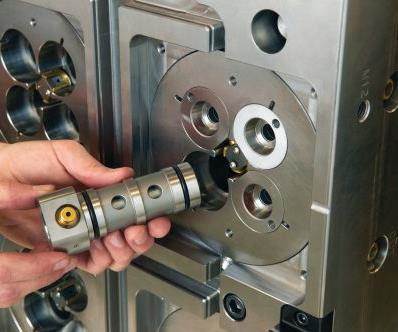In the Trenches: Tools of the Trade
Equipping yourself with the right tools for the job requires time, practice, ownership and maintenance.
I went to an estate sale the other day. The woman conducting the sale said, “Not many tools here. This is definitely a woman’s sale.” That was an understatement. The tools included one hammer, one 7/16 combination wrench, one slotted screwdriver, one off-brand Phillips screwdriver, a grass trimmer and an old, rusty pitchfork. How do you manage home ownership without at least a crescent wrench and a pair of pliers?
This got me thinking. What is a toolmaker without tools? Our tools are indispensable and inseparable from the work we do. I’ve known high-caliber toolmakers who were minimalists when it came to tools, possessing only a roll-around (no top box) and drawers sparsely filled with the bare necessities. I’ve also known run-of-the-mill machinists who had Kennedy high-rises with three indicators and five depth micrometers. A lack of tools may prevent one from accomplishing certain tasks, but an excess of tools does not ensure accurate and efficient work.
I’ve uttered the phrase “a guy can’t have too many tools” countless times, but after becoming “a man of a certain age” who attends too many estate sales where excess possessions are unloaded at bargain-basement prices, I’m not so sure that phrase is true. Having the right tool for the job is a must, but having 4-, 6-, 8- and 12-inch dial calipers is probably going to the extreme. I had to buy a 4-inch caliper before realizing it was more cute than useful.
So how many tools do you need and what is the right mix? By this point in my career, I have far more tools than necessary for my job, but each one did serve a purpose at one time. My collection of tools reflects more than 30 years in moldmaking, tool and die, and repair facilities. Admittedly, most tools for any machining trade are the same, and every skilled tradesman should have his own set of basic measuring tools. A toolmaker’s apron has a pocket designed for a one-inch micrometer for a reason. It is by far the most frequently used measuring tool.
This begs the question, “Which tools should be personally owned and which should be shop-supplied?” If you’ve had to borrow a tool more than a couple times, you need one of your own. If you’re constantly making do, thinking that “if I just had such-and-such, this job would be much easier, faster or more accurate,” then you need to buy it. If the shop supplies something you need, but the trip to the tool crib wastes five minutes every time you need it, it’s time to buy your own. Tools should make life easier and improve your quality and output.
Having the right mix of tools is fundamental, but tool maintenance is just as important as tool ownership. Although I am not a “neat freak,” I do take care of my tools. I had 5S in my toolbox 25 years before I ever heard the term, and two decades into my career I still had the complete set of Allen wrenches I bought when I first got started. (I know this because I engraved my name on each of them—all the way down to the 1/16-inch one).
Quality tools come at a price. Most of the tools I bought 30 years ago easily cost twice as much today. You don’t want to be replacing them too often, so proper practices for storing, cleaning, lubricating and calibrating your tools are essential to ensure a lifetime of service.
The most important thing about tools is knowing how to use them. Perhaps that’s the genesis of the term toolmaker. The guy with the knowledge and skill will make the tool to do the job.
Take measuring tools, for example. Two people of equal skill can use a micrometer and get two different readings because each has a different “feel” and calibrates his tool to that feel. This is why basic measuring tools should be personally owned. If you want an extremely accurate reading, get your own micrometer rather than trust someone else’s.
Skill with tools goes beyond feel. For example, we have high-quality combination squares with scales down to 0.010 increments, and I’ve seen guys with many years of experience lay out and drill clearance holes that “missed it by that much.” I’ve seen setups that could have been done simply and rigidly made complicated and fragile due to a lack of skill or an attempt to impress one’s self.
When I was starting out, I agonized over every tool purchase more than $10. I even asked a seasoned toolmaker whether I should buy a $30 import V-block or a $130 American-made V-block. Rather than defaulting to “buy a quality American-made tool, you’ll never regret it,” he walked me through the uses of a V-block and how inaccurate it would have to be to have an appreciable effect on the work I would do with it. He also showed me how to check its accuracy, and either tweak it or return it if I was not satisfied. After 30 years, I still have a $30 V-block.
Buy the tools you need to do your job, buy good quality tools, and take care of them. Most importantly, learn how and when to use them, acquire the knowledge of your mentors and peers, and develop the skills by repeated practice.
Related Content
SyBridge Technologies Acquires Wachusett Precision Tool
Wachusett Precision Tool, a manufacturer of high precision prototype, pilot and production molds for medical and consumer packaging, is Sybridge’s eleventh acquisition since opening in 2019.
Read MoreU.S. Economy Indicates Prospects for Moldmakers
An examination of the U.S. economy suggests its resilience against a recession, yet a mixed outlook for moldmaking and plastics persists.
Read MoreLeading Mold Manufacturers Share Best Practices for Improving Efficiency
Precise Tooling Solutions, X-Cell Tool and Mold, M&M Tool and Mold, Ameritech Die & Mold, and Cavalier Tool & Manufacturing, sit down for a fast-paced Q&A focused on strategies for improving efficiencies across their operations.
Read MoreMold Builder Uses Counter-Intuitive Approach for Mold Challenges
Matrix Tool Inc. answers customers’ hard questions with creative solutions for cavity spacing, tool sizing, runner layout and melt delivery that reveal the benefits of running in a smaller press size at lower cavitation but higher yield.
Read MoreRead Next
In the Trenches: Mold Repair
In this multi-part series of articles, contributer James Bourne, a tool repair supervisor and freelance writer, shares his own personal struggles in the business, as well as lessons learned and tricks of the trade garnered along the way.
Read MoreHow to Use Strategic Planning Tools, Data to Manage the Human Side of Business
Q&A with Marion Wells, MMT EAB member and founder of Human Asset Management.
Read MoreReasons to Use Fiber Lasers for Mold Cleaning
Fiber lasers offer a simplicity, speed, control and portability, minimizing mold cleaning risks.
Read More










.png;maxWidth=300;quality=90)


















